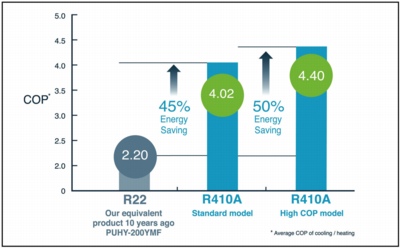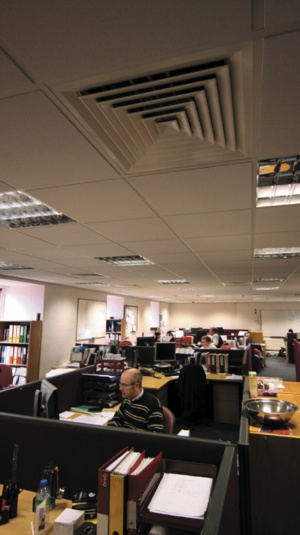2011 — the year to consider an air-conditioning upgrade

Martin Fahey explains why now is the time for clients to be encouraged to think about upgrading to more energy-efficient air-conditioning systems.
The decision to upgrade an air-conditioning system is quite a big step, but there are now a number of factors that should be encouraging consultants and contractors to encourage their clients to think carefully about making this move.
Now the Carbon Reduction Commitment Energy Efficiency Scheme (CRC EES) is in force, even though Government is still carrying out consultations on possible simplification of the scheme, consultants and end users should be think carefully about the energy-using systems in their buildings. Supporting the objectives of the CRC EES is our Green Gateway philosophy, which is about encouraging clients to think about energy use and carbon emissions, as well as incorporating renewable technologies to generate of heat and power and taking a long-term view of these issues.
'There is no getting away from the fact that if a building's heating, ventilation and cooling are provided by air conditioning and mechanical systems, these will contribute to energy use and, hence, an organisation’s carbon emissions. It is important for those advising clients to encourage them to consider any steps that could help minimise emissions.
The CRC has been in force since April 2010, and participants are identified as organisations using more than 6000 MWh per year of electricity, which is the equivalent of an annual electricity bill of about £500 000 per year. Those taking part in the scheme will have to measure and report on their carbon emissions annually — starting from July 2011.
The CRC EES is a good reason to consider investing in new and more energy-efficient air conditioning. From 2012 CRC participants will buy carbon allowances from the Government each year to cover measured emissions from the previous year.
To date, the announced price has been set at £12 per tonne of carbon dioxide. This cost will rise in the future and the money raised through the scheme will go directly to Government, making the CRC EES a key policy in moving the focus towards the carbon emissions of companies, meaning every way of reducing the impact needs to be investigated.
But are the capital costs of a new air-conditioning system justifiable?
That is the question that clients will naturally ask. However, we believe that with the major energy savings that are possible, the long-term savings both on energy bills and CRC EES allowances will ensure excellent payback figures.
The CRC EES is not the only legislative driver that clients need to consider. The Ozone Depleting Substances Regulations (ODS) are also impacting on the use of refrigerants in air-conditioning systems. Since January 2010, it has been illegal to use virgin HCFCs such as R22, so air-conditioning systems operating with this refrigerant are restricted to using recycled or reconditioned R22.
The ODS is already affecting the running costs of R22 air-conditioning systems. The price of recycled R22 is rising because little is re-entering the market; also not all of it can be recovered. Estimates are that the price of recycled R22 is already three-times that of virgin R22 before the ban.
A further deadline is on the horizon; from 1 January 2015, the use of all HCFCs, including recycled or re-conditioned R22, will be banned. Systems can still operate on this refrigerant, but owners and operators will be prohibited from opening the refrigerant systems during maintenance. Any organisation with business-critical air-conditioning systems using R22 needs to carefully consider how it is going to deal with the current prohibition on virgin refrigerant and the future ban.
Other rules under ODS include the fact that system maintenance and R22 refrigerant handling can only be carried out by correctly qualified individuals. The Government has established a number of accredited courses and training bodies. Clearly, this will make the operation of an R22-based air conditioning system more challenging.

Of course, it is not simply a case of legislation driving the need to upgrade, there are also important benefits to consider.
One important point is that building-services technologies for heating, cooling and ventilating are always under development so over the last 10 years, for example, systems have seen major improvements in energy efficiency. A new air-conditioning system, for example, could use 40% to 50% less energy than one which is 10 years old.
With that sort of energy saving, end-users would quickly see reduced energy bills. So with legislative and financial drivers to save energy, it is the right time for consultants and installers to encourage their clients to consider the option of a new system and to take advantage of all the benefits that this can bring.
Refurbishment is the key to carbon-reduction targets for the UK. Bringing our existing building stock up to speed in terms of energy efficiency will be vital to meet UK carbon reduction targets.
Make the CRC EES your reason for a better building.
Organisations that decrease their emissions can lower their costs under the CRC EES.
Government intention to date has been to set the first carbon-dioxide permits at £12 per tonne through to 2012/13, with the price set by market supply and demand forces after that.
Another important driver is the phasing out of R22, with 1 January 2015 being the deadline after which no virgin or recycled HCFCs can be used, so air-conditioning systems using R22 are particularly vulnerable to the effects of this rule.
Martin Fahey is Green Gateway manager for Mitsubishi Electric.








